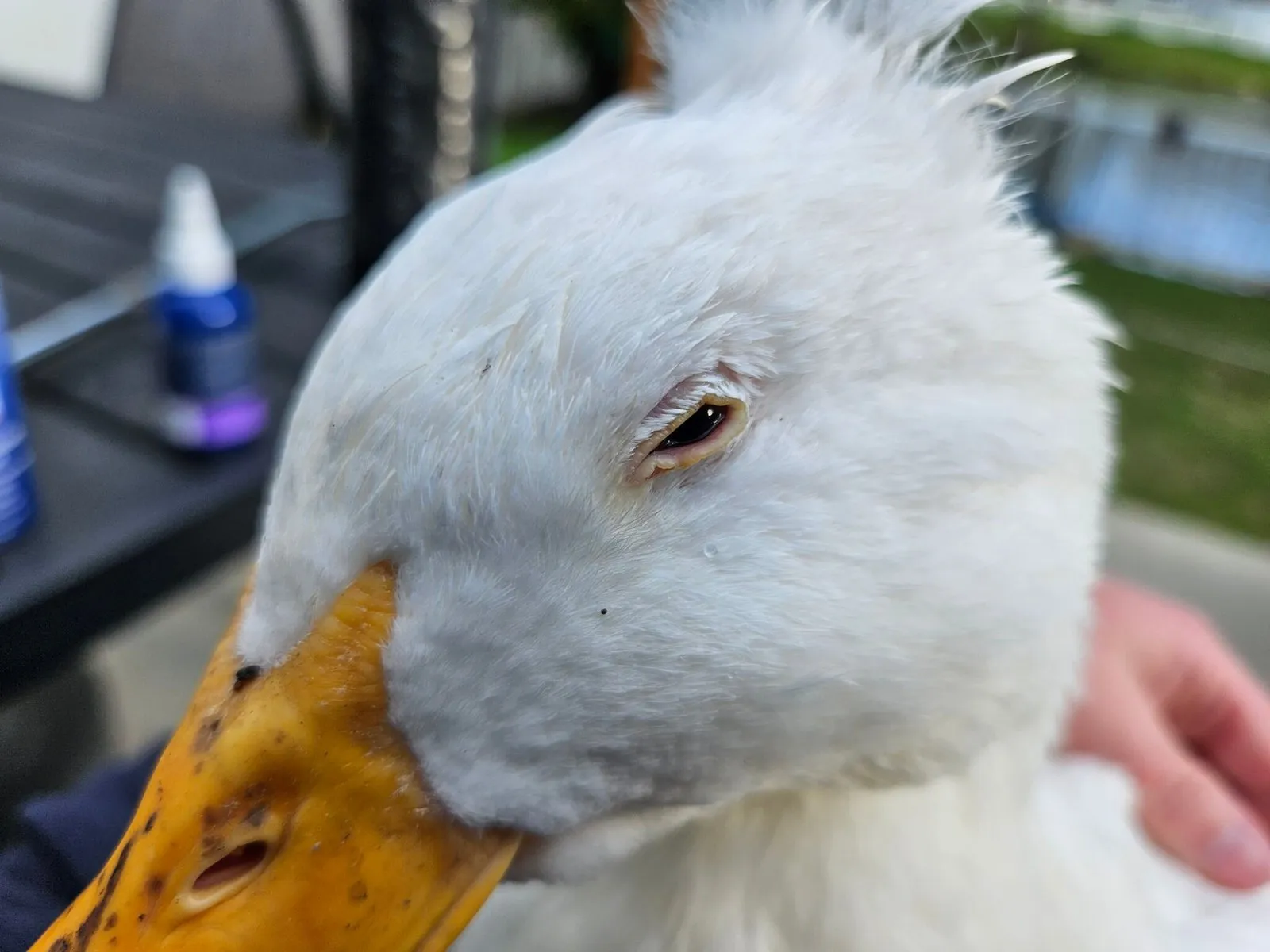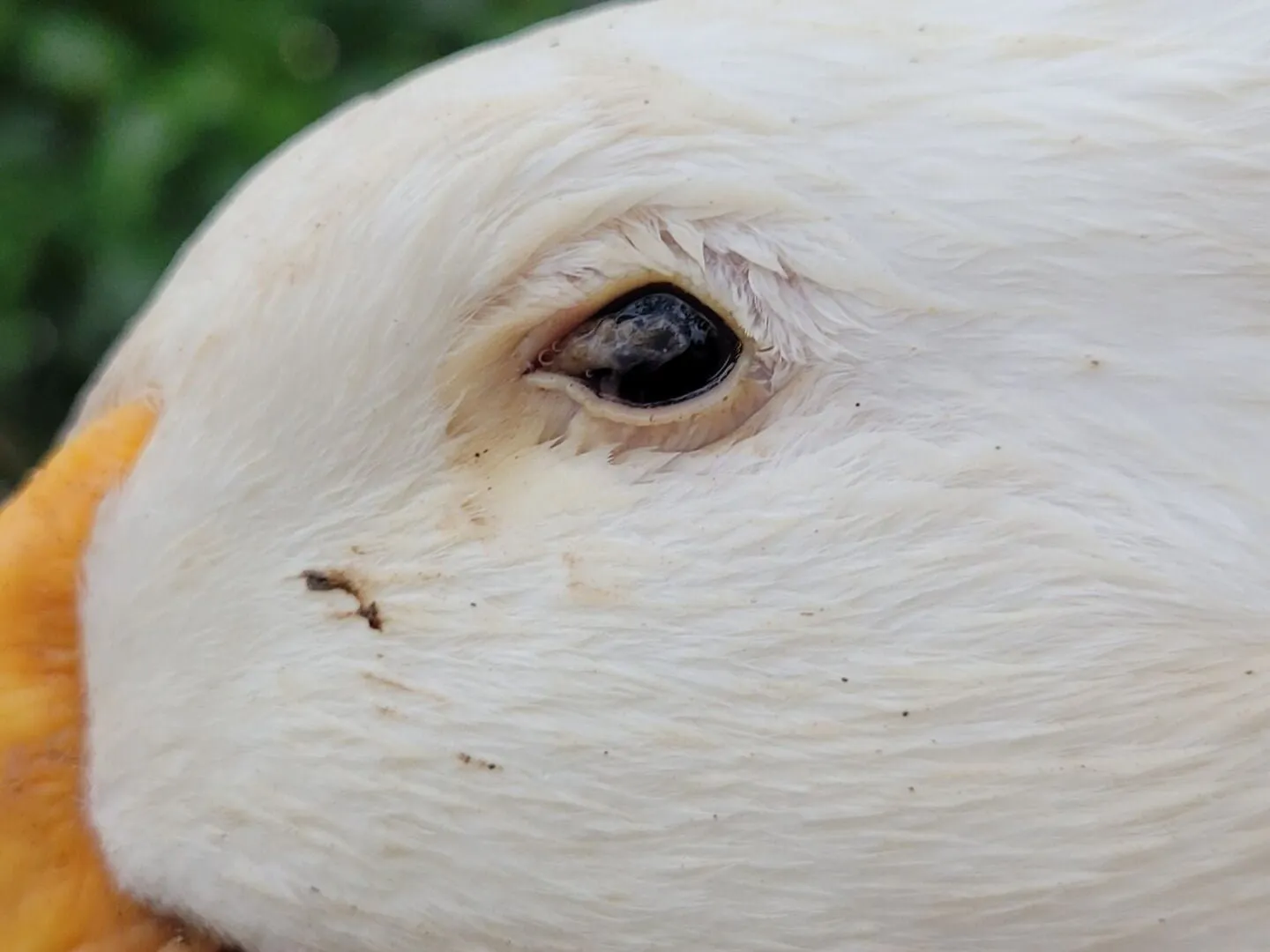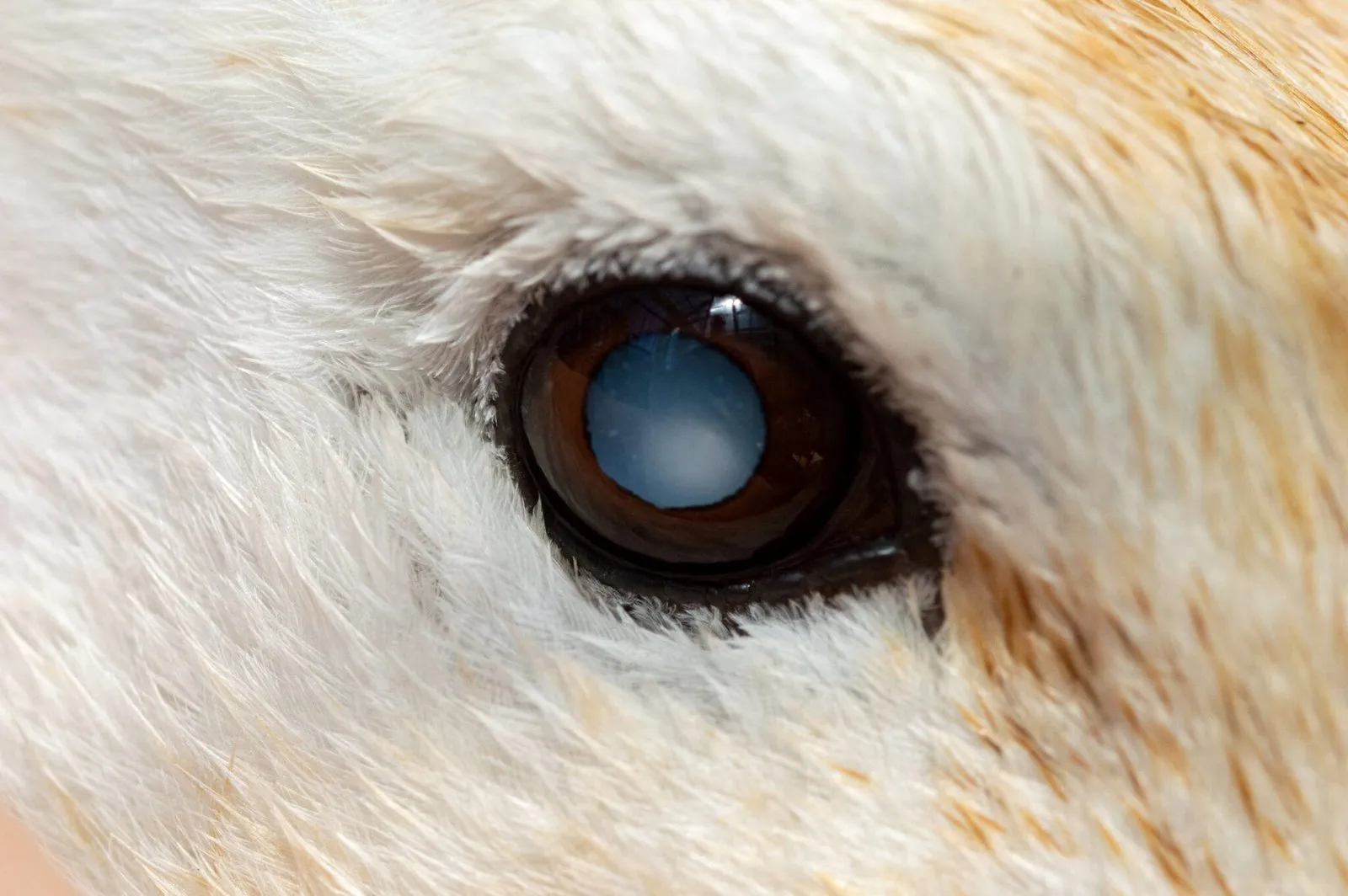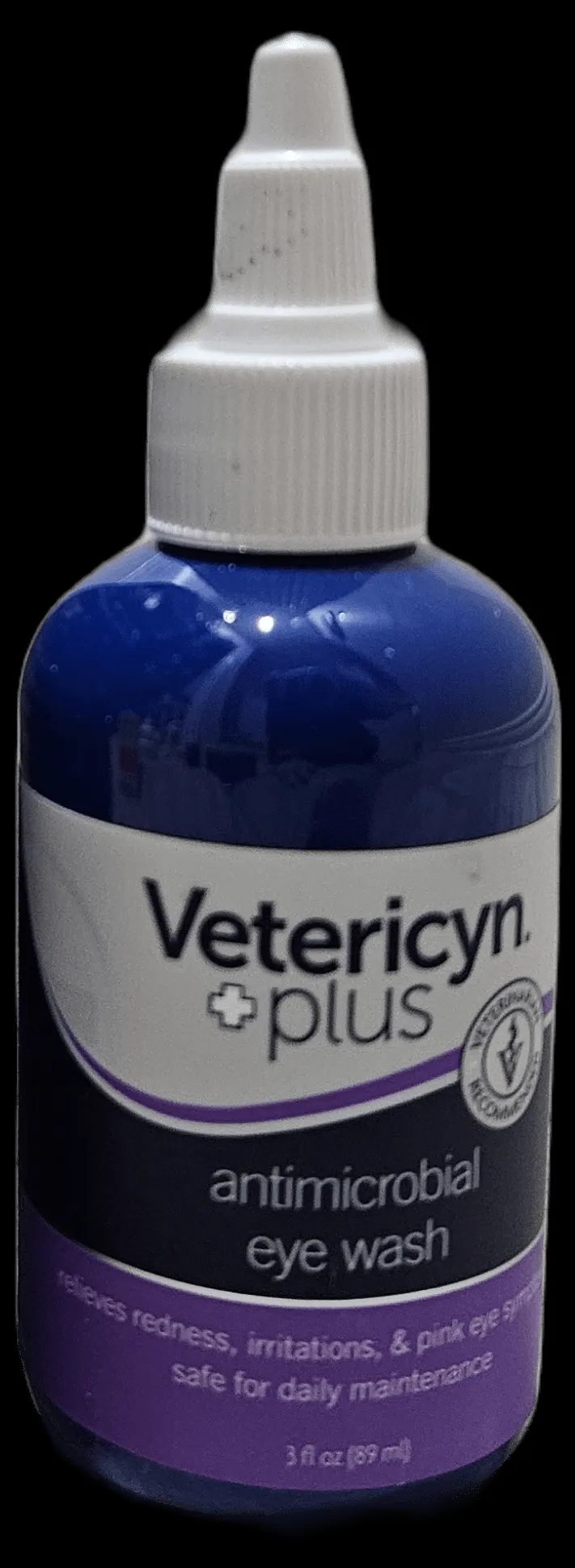Ducks are remarkable creatures, and their eyesight is vital for navigating their environment, foraging, and interacting with their flock. Ensuring their ocular health is a cornerstone of responsible duck care. This comprehensive guide delves into everything duck owners need to know about eye infections, with a particular focus on effective strategies for Treating Duck Eye Infection, understanding their causes, recognizing symptoms, and implementing robust prevention measures. By staying informed and proactive, we can help our feathered friends maintain clear vision and enjoy a lifetime of health and vitality.
Understanding Duck Eye Infections: Causes and Risk Factors
To effectively manage and prevent eye infections in ducks, it’s crucial to first understand the various underlying causes. Ducks are susceptible to numerous factors that can lead to ocular infections, including environmental stressors, pathogens, injuries, and nutritional deficiencies. By familiarizing ourselves with these root causes, we can better tailor our care practices to safeguard our flock’s ocular health and minimize the need for treating duck eye infection.
Common Causes of Eye Infections in Ducks
Ducks, with their remarkable adaptability to diverse environments, are generally resilient creatures. However, various factors can predispose them to eye infections. Let’s take a look at some of the most common causes:
- Bacterial Infections: Pathogens such as Escherichia coli, Staphylococcus aureus, and Pseudomonas spp. can infiltrate the tissues surrounding a duck’s eye, leading to inflammation and infection. These bacteria may gain entry through minor abrasions, exposure to contaminated water sources, or overcrowded living conditions, making early identification key for treating duck eye infection.
- Viral Infections: Ducks are susceptible to viral infections that can affect the eyes, such as avian influenza and duck viral enteritis. These viruses can cause severe inflammation and damage to the ocular tissues, compromising the duck’s vision and overall health.
- Fungal Infections: Fungi such as Aspergillus and Candida species can thrive in damp, humid environments commonly found in duck coops. These fungi may colonize the ocular tissues, resulting in fungal keratitis or other localized infections.
- Environmental Irritants: Ducks frequently forage in various outdoor environments, exposing their eyes to potential irritants such as dust, pollen, and airborne pollutants. Prolonged exposure to these irritants can trigger inflammation and predispose ducks to secondary infections. Avoiding mowing the lawn around ducks can also help prevent irritation.
- Trauma or Injury: Ducks are naturally curious and may inadvertently injure their eyes while exploring their surroundings. Sharp objects, aggressive behavior from other ducks, or accidental collisions with structures or obstacles can cause trauma to the delicate eye tissues, leading to infections.
- Parasitic Infestations: External parasites such as mites or ticks can infest the area around a duck’s eyes, causing irritation, scratching, and potential damage to the ocular tissues. Certain internal parasites may also migrate to the eye tissues, further exacerbating the infection.
- Nutritional Deficiencies: Inadequate nutrition can compromise a duck’s immune system, making them more susceptible to infections. Deficiencies in essential vitamins and minerals, such as vitamin A or selenium, can impair the duck’s ability to maintain healthy ocular tissues and effectively fight off infections.
By understanding the common causes of eye infections in ducks, we can take proactive measures to mitigate risk factors and safeguard the ocular health of our feathered friends. Through diligent observation, prompt intervention, and proactive prevention strategies, we can ensure that our ducks enjoy a lifetime of clear-eyed happiness and vitality.
 Duck Emma with signs of an eye infection, possibly showing redness or discharge
Duck Emma with signs of an eye infection, possibly showing redness or discharge
Recognizing the Signs and Symptoms of Duck Eye Infections
As vigilant duck guardians, it’s essential to recognize the subtle signs and symptoms that may indicate the presence of an eye infection in our feathered companions. While ducks may not vocalize their discomfort in the same way humans do, they often exhibit observable changes in behavior or physical appearance when experiencing ocular issues. Early detection is a critical first step towards successfully treating duck eye infection. Here are some key signs and symptoms to watch for:
- Excessive Blinking or Squinting: Ducks with eye infections may frequently blink or squint their eyes in an attempt to alleviate discomfort or sensitivity to light. This repetitive blinking or squinting may be more pronounced than usual and can indicate irritation or inflammation of the ocular tissues.
- Redness, Swelling, or Inflammation: Inflammation of the eyelids or surrounding tissues is a common manifestation of eye infections in ducks. Affected ducks may exhibit redness, swelling, or puffiness around one or both eyes, indicating an inflammatory response to infection or injury.
- Discharge or Mucus Accumulation: Eye infections often produce abnormal discharge or mucus from the affected eye. This discharge may vary in color and consistency, ranging from clear or translucent to thick and opaque. Ducks may attempt to remove the discharge by rubbing their eyes with their feet or wings.
- Foamy Discharge Around the Eye: This condition is characterized by a white, frothy discharge forming around one or both eyes, indicating the presence of “foamy eye,” a common condition in ducks.
- Loss of Feathers around the Eye: This can indicate an eye infection in ducks, as inflammation and irritation may lead to feather loss in this area. Additionally, the ducks may scratch themselves frequently, which can also cause them to lose feathers in this area.
- Cloudiness or Opacity in the Eye: Cloudiness or opacity in the affected eye is a telltale sign of ocular inflammation or infection. The normally clear and transparent cornea may become hazy or cloudy, impairing the duck’s vision and causing discomfort.
- Decreased Activity or Appetite: Ducks experiencing eye infections may exhibit a noticeable decrease in activity levels or appetite. They may appear lethargic, reluctant to engage in normal behaviors such as swimming or foraging, and may show little interest in food or treats.
- Altered Eye Behavior: Ducks with eye infections may exhibit peculiar behaviors related to their affected eyes. They may repeatedly rub or scratch at the affected eye with their feet or wings in an attempt to alleviate itching or discomfort. Additionally, ducks may hold their affected eye closed or partially closed, avoiding exposure to bright light or irritants.
- Behavioral Changes in Social Interactions: Ducks are highly social creatures and rely on visual cues to communicate with their flockmates. Ducks with eye infections may exhibit changes in their social interactions, such as avoiding close contact with other ducks, displaying aggression or defensive behaviors, or becoming isolated from the group.
By carefully observing our ducks for these signs and symptoms, we can promptly identify and address any potential eye infections, ensuring our feathered friends receive the necessary care and treatment to restore their ocular health and overall well-being. Remember, early intervention is key to preventing complications and promoting a speedy recovery for our beloved ducks.
 A close-up of a duck's head, showing a slightly irritated eye area, representing an eye infection
A close-up of a duck's head, showing a slightly irritated eye area, representing an eye infection
Foamy Eye: A Closer Look
Foamy eye, also known as bubble eye, is a condition observed in ducks where a white, foamy discharge develops around one or both eyes. While its appearance may seem alarming, it doesn’t always indicate a severe eye ailment. However, it’s a symptom that warrants attention when considering treating duck eye infection.
The primary cause of foamy eye is often an upper respiratory infection, typically bacterial in origin. In response, the duck’s body generates the frothy discharge as a natural defense mechanism to expel irritants and combat the infection. Symptoms like sneezing, coughing, or labored breathing may accompany the foamy discharge.
However, not all instances of foamy eyes signify an infection. Minor eye irritations, such as debris or scratches resulting from encounters with fencing or branches, can also trigger its occurrence. Furthermore, during mating season, the gripping behavior of male ducks on the female’s neck during copulation can inadvertently irritate her sinuses, developing foamy eyes.
 A duck's eye with visible white, frothy or foamy discharge, indicating a "foamy eye" condition
A duck's eye with visible white, frothy or foamy discharge, indicating a "foamy eye" condition
Cloudiness and Cataracts in Ducks
Cataracts are a common cause of cloudiness in a duck’s eye and occur when the lens of the eye becomes cloudy or opaque, impairing vision. While cataracts can develop in ducks of any age, they are more commonly observed in older individuals. Factors such as genetics, nutrition, and environmental stressors can contribute to the development of cataracts in ducks. As the cataract progresses, it interferes with the duck’s ability to see clearly, leading to vision impairment and potential blindness if left untreated. Recognizing this condition is important when evaluating the broader scope of treating duck eye infection.
The onset of cataracts in ducks may initially manifest as a slight haziness or opacity in the lens, gradually progressing to more severe cloudiness over time. Ducks with cataracts may exhibit symptoms such as squinting, difficulty navigating their surroundings, or reluctance to engage in activities that require precise vision, such as foraging or social interactions with other ducks.
 A close-up macro shot of a domestic breed duck's eye, clearly showing a cataract causing cloudiness in the lens
A close-up macro shot of a domestic breed duck's eye, clearly showing a cataract causing cloudiness in the lens
Fortunately, cataracts in ducks can often be successfully treated through surgical intervention. During cataract surgery, the cloudy lens is removed and replaced with a synthetic lens, restoring clarity to the duck’s vision. While cataract surgery in ducks carries some risks, including infection and inflammation, it can significantly improve the duck’s quality of life and allow them to continue enjoying their natural behaviors.
As caretakers, it’s crucial to monitor your duck for signs of cataracts, such as cloudiness in the eye, and seek veterinary care promptly if detected. Early diagnosis and intervention can help prevent further progression of the cataract and preserve your duck’s visual health and overall well-being. Additionally, providing a balanced diet rich in essential nutrients and minimizing environmental stressors can help reduce the risk of cataract formation in ducks and promote optimal eye health throughout their lives.
Prevention Strategies to Safeguard Duck Eye Health
While prompt treatment is crucial for effectively treating duck eye infection, prevention is always preferable. By implementing proactive measures and creating a safe, clean environment for our feathered friends, we can minimize the risk of ocular issues and promote optimal eye health. Here are some effective prevention strategies to consider:
- Maintain a Clean Living Environment: Regularly clean and sanitize your duck’s living area, including their coop, pen, or pond. Remove any debris, feces, or stagnant water that may harbor bacteria, fungi, or parasites that could pose a risk to eye health.
- Provide Adequate Ventilation: Ensure proper ventilation in your duck’s housing area to prevent the buildup of humidity, moisture, and airborne contaminants that could contribute to eye irritation or infection. Proper airflow helps maintain a dry, comfortable environment for your ducks.
- Optimize Nutrition: Provide your ducks with a balanced diet rich in essential nutrients, vitamins, and minerals to support their overall health and immune function. Ensure they have access to fresh, clean water and high-quality feed formulated specifically for ducks.
- Monitor Water Quality: Ducks love to splash and swim, but dirty or contaminated water can pose a significant risk to their eye health. Regularly monitor the quality of their water sources, such as ponds, pools, or drinking bowls, and ensure they are clean, free of debris, and regularly refreshed.
- Minimize Exposure to Irritants: Ducks frequently forage and explore their surroundings, exposing their eyes to potential irritants such as dust, pollen, and airborne pollutants. To minimize their exposure to these irritants, provide clean, dry bedding and avoid overcrowded living conditions.
- Practice Good Hygiene: Maintain good hygiene practices when handling your ducks, their food, and their living environment. Wash your hands thoroughly before and after interacting with your ducks, and avoid introducing potential contaminants or pathogens into their environment.
- Monitor for Signs of Eye Irritation or Infection: Keep a close eye on your ducks for any signs of eye irritation, redness, discharge, or behavioral changes. Early detection of potential issues allows for prompt intervention and treatment, minimizing the risk of complications and promoting a speedy recovery.
- Monitor for Aggressive Behavior, Especially During Mating: During mating season, ducks, particularly drakes, may exhibit territorial and aggressive behavior towards each other. This aggression can escalate into physical confrontations, including pecking, chasing, and aggressive mating attempts. Keep a close eye on your ducks during mating season and be vigilant for signs of excessive aggression towards other ducks, especially females. Intervene immediately if you observe any aggressive behavior, and consider separating aggressive individuals to prevent injuries and maintain a harmonious flock dynamic.
- Separate Ducks to Prevent Injuries: In situations where aggressive behavior persists or escalates, it may be necessary to separate ducks to prevent injuries and ensure the safety and well-being of all flock members. Provide separate enclosures or pens for ducks displaying aggressive behavior, allowing them time to cool off and reducing the risk of further conflict. Monitor separated ducks closely for any signs of injury or distress and reintegrate them into the flock once aggression has subsided, or consider permanent separation if necessary for the safety of all ducks involved.
- Regular Veterinary Check-ups: Schedule regular veterinary check-ups for your ducks to ensure their overall health and well-being. A qualified avian veterinarian can conduct thorough examinations, provide valuable guidance on preventive care, and address any emerging health concerns promptly.
By implementing these proactive prevention strategies and maintaining a vigilant eye on your duck’s health and environment, you can help minimize the risk of eye infections and promote optimal ocular health for your beloved feathered companions. Remember, prevention is always better than cure when it comes to safeguarding the well-being of our ducks.
 A bright-eyed duck, healthy and alert, representing good eye health and the success of prevention
A bright-eyed duck, healthy and alert, representing good eye health and the success of prevention
Effective Treatment Options for Duck Eye Infections
When faced with an eye infection in our beloved ducks, prompt and appropriate treatment is essential to facilitate a speedy recovery and prevent complications. The following outlines several effective options for treating duck eye infection.
- Gentle Cleansing: Begin by meticulously cleaning the affected eye with a gentle, saline solution or lukewarm water to remove any discharge, debris, or foreign particles. Use a clean gauze pad or soft cloth to wipe away the discharge, taking care not to apply excessive pressure or further irritate the eye.
- Vetericyn Plus Eye Wash: Vetericyn Plus Eye Wash is specifically formulated to gently flush irritated eyes and ease symptoms of pink eye and other irritations. This gentle solution helps reduce allergy symptoms, redness, and tear stains, promoting overall eye health for your duck. It’s safe for daily use and can be a valuable part of your duck’s first aid kit, especially for mild infections.
- Antibiotic Ointment or Drops: Your veterinarian may prescribe antibiotic ointment or eye drops for your duck, such as Vetropolycin, for bacterial eye infections. Apply the medication to the affected eye according to your veterinarian’s instructions, ensuring thorough coverage of the affected area. Over-the-counter options like Terramycin Antibiotic Ophthalmic Ointment (containing oxytetracycline and polymyxin B) can also be highly effective for bacterial infections, helping to reduce inflammation and promote healing.
- Anti-inflammatory Medication: To alleviate discomfort, reduce swelling, and promote healing, your veterinarian may recommend anti-inflammatory medication such as nonsteroidal anti-inflammatory drugs (NSAIDs) or corticosteroids. These medications help to alleviate pain and inflammation, allowing the duck to recover more comfortably. Meloxicam is an example of a common prescription from vets.
- Environmental Modifications: Ensure your duck’s living environment is clean, dry, and free of potential irritants that could exacerbate the eye infection. Remove any sources of contamination, such as soiled bedding, stagnant water, or overcrowded living conditions, and provide adequate ventilation to promote a clean and hygienic environment conducive to healing.
- Nutritional Support: Provide your duck with a balanced diet rich in essential nutrients, vitamins, and minerals to support their overall health and immune function. Consider supplementing their diet with additional vitamin A, which is crucial for maintaining healthy eyes and supporting the healing process.
- Supportive Care: Provide your duck with supportive care and attention during their recovery period. Monitor their condition closely for any signs of improvement or worsening symptoms, and adjust their treatment plan as necessary in consultation with your veterinarian.
- Veterinary Consultation: Consult with a qualified avian veterinarian for a comprehensive evaluation and diagnosis of your duck’s eye infection. Your vet can provide valuable guidance on treatment options, dosage recommendations, and additional supportive care measures tailored to your duck’s specific needs.
 Terramycin Antibiotic Ointment packaging, a common treatment for bacterial eye infections
Terramycin Antibiotic Ointment packaging, a common treatment for bacterial eye infections
By implementing these treatment options and working closely with your veterinarian, you can effectively manage and treat eye infections in ducks, ensuring a speedy recovery and restoring your feathered friend’s ocular health and well-being. Early intervention and proactive care are key to successful treatment outcomes for our beloved ducks.
Conclusion
As dedicated duck parents, it’s our responsibility to prioritize the health and well-being of our feathered companions. By arming ourselves with knowledge about the causes, symptoms, and most importantly, effective methods for treating duck eye infection, we can ensure that our ducks enjoy a lifetime of clear-eyed adventures. Remember, a little care goes a long way in preserving the precious gift of sight for our beloved quackers!
